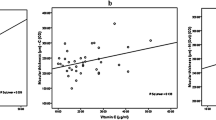Abstract
Oxygen free radicals (OFRs) have been implicated in the pathogenesis of diabetic microangiopathy. The effects of serum from insulin-dependent diabetes mellitus patients with or without retinopathy on the production of superoxide anion by normal polymorphonuclear leukocytes (PMNs) were measured spectrophotometrically and compared with that of age matched controls. Superoxide anion production by PMNs incubated with serum from retinopathy-free patients or patients with retinopathy was significantly higher than that of controls (P=0.0002 and 0.0001, respectively). Furthermore, superoxide anion production by PMNs incubated with serum from patients with retinopathy was significantly higher than retinopathy-free patients (P=0.02). These observations suggest that a diabetic serum factor provoked a significant generation of superoxide anion in normal PMNs, a phenomenon found parallel to the presence of retinopathy, indicating that OFRs may play a role in the progression of diabetic retinopathy. The nature of this serum factor remains to be clarified.
Similar content being viewed by others

References
Recsvarady Z, Fisher TC, Darwin CH, Fabok A, Maqueda TS, Saad MF, Meiselman HJ. Decreased polymorphonuclear leukocyte deformability in NIDDM. Diabetes Care 1991; 17: 57–63.
Schroder S, Palinski W, Schmid-Schonbein GW. Activated monocytes and granulocytes, capillary non perfusion and neovascularization in diabetic retinopathy. Am J Pathol 1991; 139: 81–100.
Freedman SF, Hatchell DL. Enhanced superoxide radical production by stimulated polymorphonuclear leukocytes in a cat model of diiabetes. Exp Eye Res 1992; 55: 767–773.
Kantar A. Wilkins G, Swoboda B, Littarlu GP, Bertoli E, Catassi C, Coppa G, Giorgi PL. Alterations of respiratory burst of polymorphonuclear leukocytes from diabetic children. A chemiliuminescence study. Acta Paediatr Scand 1990; 79: 535–541.
Watanaba A, Tomino Y, Yokoyama K, Koide H. Production of hydrogen peroxide by neutrophilic polymorphonucelar leukocytes in patients with diabetic nephropathy. J Clin Lab Anal 1993; 7: 209–213.
Cohen HJ, Chovaniec ME. Superoxide generation by digitonin-stimulated guinea pig granulocytes. J Clin Invest 1978: 61: 1081–1087.
Sinclair AJ. Free radical mechanisms and vascular complications of diabetes. Diab Rev 1993; 2: 7–10.
Oberley LW. Free radicals and diabetes. Free Radic Biol Med 1988; 5: 113–124.
Low PA, Nickander KK. Oxygen free radical effects in sciatic nerve in experimental diabetes. Diabetes 1991; 40: 873–877.
Horio F, Fukuda M, Katoh H, Petruzzelli M, Yano N, Rittershaus C, Bonner-Weir S, Hattori M. Reactive oxygen intermediates in autoimmune islet cell destruction of NOD mouse induced by peritoneal exudate cellls (rich in macrophages) but not T cells. Diabetologia 1994; 37: 22–31.
Rabinovitch A, Suarez WL, Power RF. Lazaroid antioxidant reduces incidence of diabetes and insulitis in nonobese diabetic mice. J Lab Clin Med 1993; 121: 603–607.
Weiss SJ. Tissue destruction by neutrophils. N Eng J Med 1989; 320: 365–376.
Shah SV, Wallin JD, Eilen SD. Chemiluminescence and superaxide anion production by leukocytes from diabetic patients. J Clin Endocrinol Metab 1983; 57: 402–409.
Pickering LK, Clearly TG, Getz S. Effect of glucose concentration and time on polymorphonuclear leukocyte function. J Clin Lab Immunol 1982; 8: 31–55.
Denichilo MO, Stewart AG, Vadas MA, Lopez AF. Granulocyte-macrophage colony-stimulating factor is a stimulus of platelet-activating factor and superoxide anion generation by human neutrophils. J Biol Chem 1991; 266: 4896–4902.
Kitagawa S, Yuo A, Souza LM, Saito M, Miura Y, Takaku f. Recombinant human granulocyte colony-stimulating factor enhances superoxide release in human granuloyctes stimulated by the chemotactic peptide. Biochem Biophys Res Comm 1987; 144: 1143–1146.
Ernster L: Biochemistry of reoxygenation injury. Crit Care Med 1988; 16: 947–953.
Halliwell B. Reactive oxygen species and the central nervous system. J Neurochem 1992; 59: 1609–1623.
Anderson R, Benorhen R. Polyunsaturated fatty acids of photoreceptor membranes. Exp Eye Res 1974; 18: 205–213.
Witting L. Lipid perotidationin vivo. J Am Oil Chem Soc 1965; 42: 908–913.
Nishida T, Nakagawa S, Manabe R. Superoxide dismutase activity in diabetic rat retina. Jpn J Ophthalmol 1984; 28: 377–382.
Kadoya K. Lipoperoxide level and scavenging enzyme activities in the diabetic albino rabbit retina. Acta Soc Ophthalmol Jpn 1981; 85: 646–655.
Fantone JC, Ward PA. Role of oxygen-derived free radicals and metabolites in leukocyte-dependent inflammations. Am J Pathol 1982; 107: 397–418.
Hessler JR, Morel DW, Lewis LJ, Chisolm GM. Lipoprotein oxidation and lipoprotein-induced cytotoxicity. Arteriosclerosis 1983; 3: 215–222.
Sacks T, Moldow C, Craddock P, Bowers T, Jacob H. Oxygen radicals mediate endothelial damage by complement-stimulated granulocytes. Anin vitro model of immune vascular damage. J Clin Invest 1978; 61: 1161–1167.
Gilcrease MZ, Hoover RL. Neutrophil adhesion to endothelium following hyperosmolar insult. Diabetes Res Clin Pract 1991; 16: 149–157.
Lefer AM, Aoki N. Leukocyte-dependent and leukocyte-independent mechanisms of impairment of endothelium-mediated vasodilation. Blood vessels 1990; 27: 162–168.
Veriac S, Tissie G, Bonne C. Oxygen free radicals adversely affect the regulation of vascular tone by nitric oxide in the rabbit retina under high intraocular pressure. Exp Eye Res 1993; 56: 85–88.
Author information
Authors and Affiliations
Rights and permissions
About this article
Cite this article
Abu El-Asrar, A.M., Soliman, R.T., Al-Amro, S.A. et al. Serum factor from diabetic patients with or without retinopathy stimulates superoxide anion production by normal polymorphonuclear leukocytes. Doc Ophthalmol 91, 1–8 (1995). https://doi.org/10.1007/BF01204618
Accepted:
Issue Date:
DOI: https://doi.org/10.1007/BF01204618



